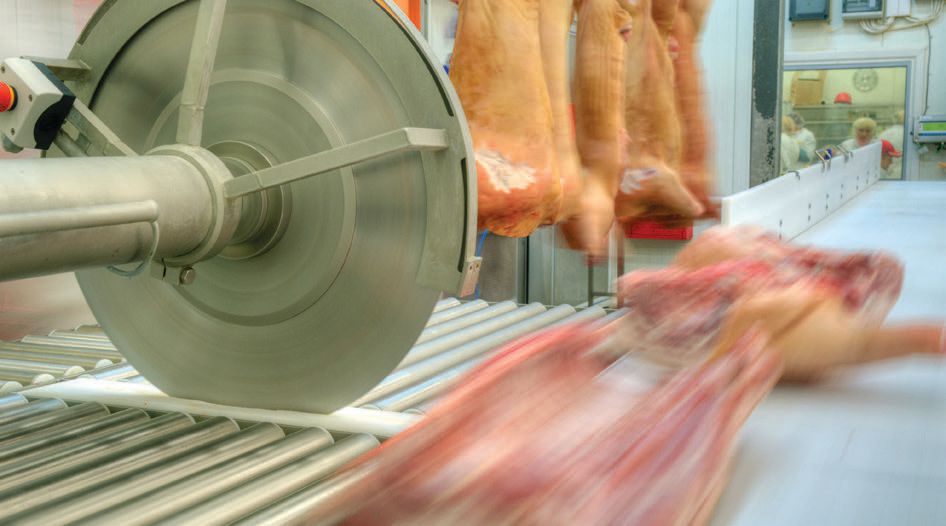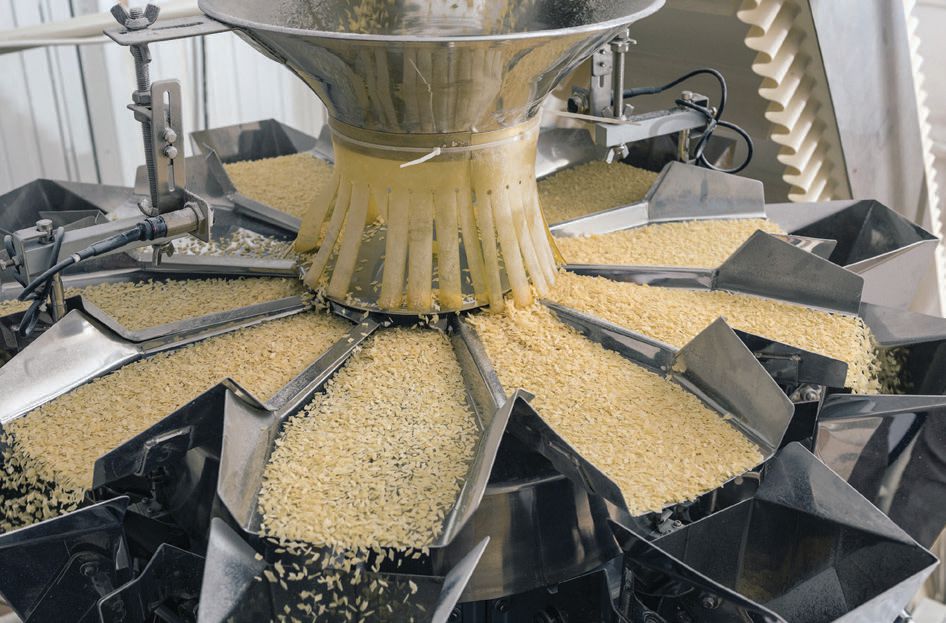Food-grade lubricants
Stuart F. Brown, Contributing Editor | TLT Technical Update September 2015
Working with federal guidelines and a restricted list of chemicals, lubricant formulators ensure the foods we eat keep us safe and healthy.
KEY CONCEPTS
•
The biggest category of food-grade lubricants is H1, which is tasteless, odorless and suitable for what’s known as incidental food contact.
•
The U.S. Department of Agriculture created a reference known as the White Book, a long list of products—including lubricants—that are considered food grade and approved for use in food processing applications.
•
When a company goes to NSF International for registration, NSF’s toxicologists review the product’s formulation for compliance with 21 Code of Federal Regulations and other applicable regulations.
LIKE ANY FACTORY, A FOOD PROCESSING PLANT IS EQUIPPED with machinery that’s full of bearings and bushings that protect various rotating, shuttling and sliding parts from the ravages of friction and mechanical loads. And like most factory equipment, food-grade machinery requires periodic lubrication. But you can’t just slather any old type of grease on moving parts that operate near food intended for human consumption. Toxicity concerns exclude lithium thickener, for example, from the list of ingredients in 21 CFR that are acceptable for use on food handling equipment.
By far the biggest category of food-grade lubricants contains those classified by regulators as H1. They are tasteless, odorless and suitable for what’s known as incidental food contact. Incidental means equipment maintainers wouldn’t intentionally put any H1 product where it might touch foodstuffs moving down a conveyor line, but should such contact accidentally occur consumers won’t be sickened by eating the affected victuals. The maximum permitted amount of lubricant in an incidental contact is 10 ppm.
For many years the U.S. Department of Agriculture (USDA), operated a regulatory program focused on chemical compounds that were used specifically in meat and poultry. The program created a long list of products—including lubricants—that were considered “food grade” and approved for use. The list itself became known as the White Book.
In the early 1990s the USDA decided to cease its regulation and approval of food-grade substances. Many stakeholders—the lubricants industry in particular—which had come to rely on the White Book, didn’t want to lose this mechanism for identifying those products acceptable for use in a food processing facility. So the USDA approached a non-profit inspection, testing and certification company called NSF International (formerly the National Sanitation Foundation), headquartered in Ann Arbor, Mich., about taking over the approval process. A second organization, InS Services in England, also offers registration of companies and products.
Registration of products and ingredients is a voluntary process that nonetheless appeals to reputable food processors because they want to see a registration mark on the product label before they bring a lubricant into their facility.
 In the past the USDA operated a regulatory program focused on chemical compounds that were used specifically in meat and poultry.
In the past the USDA operated a regulatory program focused on chemical compounds that were used specifically in meat and poultry.
www.canstockphoto.com
H1 lubricants are regulated under the Code of Federal Regulations (CFR), Title 21, Section 178.3570. The H1 products used in a plant must fit into the facility’s Hazard Analysis of Critical Control Points plan, a methodology kept on file for defining and controlling present or potential hazards in food production.
“Regular mineral base oil stocks may not be used to formulate food-grade lubricants, though certain white mineral oils, synthetic polyalphaolefins, some esters and vegetable oils can be used,” says STLE-member Anoop Kumar, director of research and development at Royal Manufacturing. Co., a lubricants maker and marketer in Tulsa, Okla.
Registration concerns food safety and toxicology rather than the performance or efficacy of a particular product. Globalization has brought with it the rapid movement of foods from one side of the world to the other, raising concerns about the safety of ingredients and processes.
Media attention to problems with food contamination and costly recalls keep the topic alive in the public’s mind. “Interpreting 21 CFR and applying it to lubricant formulations can be a complex exercise; this is where NSF’s expertise helps formulators,” explains Sarah Krol, managing director of NSF’s food safety product division.
In the world of non-food-grade grease thickeners, lithium is a common choice these days. Since lithium is excluded from the list of approved food-grade ingredients, however, formulators are faced with fewer choices when they select the materials for a grease product. Up until the early 2000s the approved thickeners were primarily anhydrous calcium for low-temperature applications and aluminum complex for high-temperature uses. Some polyurea products also were approved as were clay- and dispersion-type thickeners such as silica.
The approved formulation list has about 100 chemicals on it, far fewer than would be found on a list of ingredients for industrial lubricants in general. “There are quite a number of chemistries that, for whatever reason, either haven’t been approved or cannot be approved due to toxicity or other issues that would affect a food-grade lubricant,” says STLE-member Wayne Mackwood, research and development manager at Philadelphia-based specialty chemical supplier Chemtura Corp.
 Ingredient choices may shift somewhat as grease formulators and users seek performance benefits from different recipes.
www.canstockphoto.com
Ingredient choices may shift somewhat as grease formulators and users seek performance benefits from different recipes.
www.canstockphoto.com
When a company goes to NSF for registration, NSF’s toxicologists review the product’s formulation for compliance with the 21 CFR regulations. Part of that is scrutinizing labels to make sure they are responsible and accurate. Krol says, “Lubricant formulations, including additives, are typically extremely proprietary. Independent third-party organizations like NSF have established very robust systems and controls for managing confidential business information while ensuring all components of the product are compliant. It’s a significant part of our role as a registration body.”
An increasing focus in recent years is meeting religious prohibitions specified by Jewish Kosher and Muslim Halal dietary practices. In an annual Kosher or Halal factory inspection, a rabbi or imam will arrive unannounced to observe the ingredients being used in foods and particularly their proper segregation, which can result in food processors deciding to dedicate entire plants to compliance with these rules. Kosher and Halal inspections also focus on ingredient suppliers. They will ask questions such as: How are materials supplied? Are they in bulk or dry? How do you handle them, and how does your supplier control them?
 Food-grade machinery requires periodic lubrication; you can’t just slather any old type of grease on moving parts.
www.canstockphoto.com
Food-grade machinery requires periodic lubrication; you can’t just slather any old type of grease on moving parts.
www.canstockphoto.com
NSF’s Krol advises while food safety regulations are continually evolving, the 21 CFR requirements for incidental contact lubricant formulations remain largely static. Ingredient suppliers can utilize specific regulatory approval processes such as applying for a Food Contact Notification if they wish to use an ingredient or chemical not currently approved.
Ingredient choices, however, may shift somewhat as grease formulators and users seek performance benefits from different recipes. Thickeners are an example. Aluminum complex greases are popular for their utility across a wide range of temperatures, excellent water resistance and good extreme pressure performance. Their shortcoming is incompatibility with other types of greases.
 A food processing plant is equipped with machinery that’s full of bearings and bushings that protect various rotating, shuttling and sliding parts.
www.canstockphoto.com
A food processing plant is equipped with machinery that’s full of bearings and bushings that protect various rotating, shuttling and sliding parts.
www.canstockphoto.com
These limitations create an opening in the market for overbased calcium sulfonate greases, which provides better performance in the extreme pressure, rust preventive and water resistance categories along with superior compatibility with other greases. The term “overbased” refers to calcium carbonate’s amorphous, non-crystalline structure. In the manufacturing process, the carbonate is converted to a crystalline form, calcite, which possesses the desired properties. As more manufacturers begin offering this product, prices should come down as supply goes up.
 Stuart F. Brown is a free-lance writer who can be reached at www.stuartfbrown.com
Stuart F. Brown is a free-lance writer who can be reached at www.stuartfbrown.com.